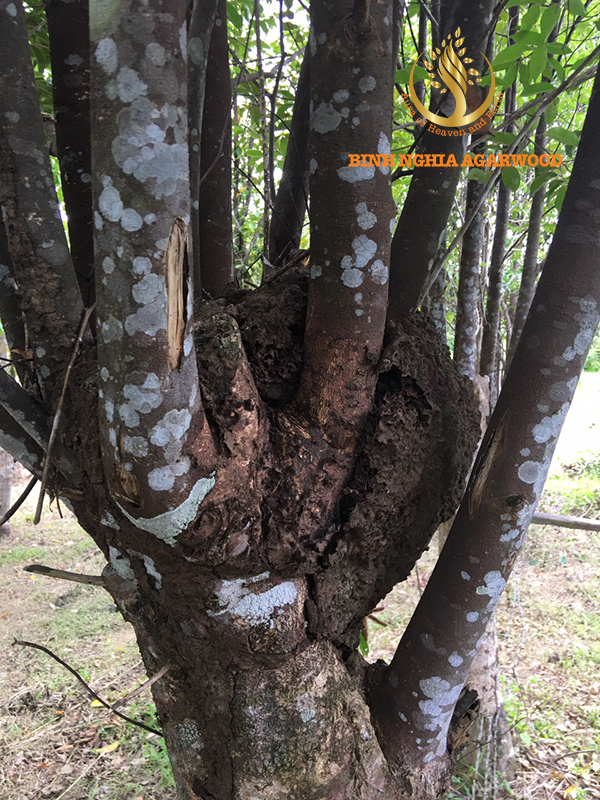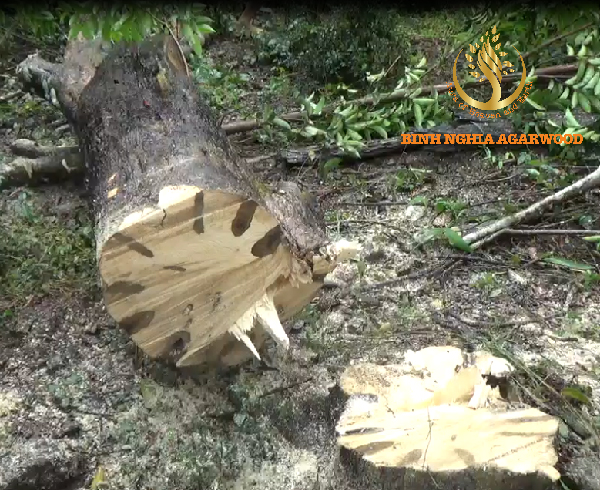Protecting a Fragrant Legacy - Binh Nghia Agarwood is at the forefront of cultivating and exploiting Oud in Vietnam
.jpg)
Discuss the importance of sustainable agarwood harvesting.
Sustainable agarwood harvesting is crucial for ensuring the long-term viability of agarwood-producing trees and preserving the ecological balance of the ecosystems in which they thrive. The importance of sustainable agarwood harvesting extends to environmental, economic, and cultural aspects. Here are key reasons highlighting its significance:
Conservation of Agarwood-Producing Species:
Many agarwood-producing species, such as Aquilaria and Gyrinops, are facing threats of overharvesting and habitat loss. Sustainable harvesting practices aim to conserve these species, preventing them from becoming endangered or extinct.
Preservation of Biodiversity:
Agarwood-producing trees contribute to the biodiversity of their ecosystems. Sustainable harvesting practices help maintain the overall health and diversity of these ecosystems, ensuring that other flora and fauna dependent on these trees also thrive.
Economic Stability for Communities:
Sustainable agarwood harvesting provides a source of income for communities that depend on the agarwood trade. By implementing practices that do not deplete resources, communities can continue to benefit economically over the long term.
Avoidance of Illegal Logging and Trade:
Sustainable harvesting helps curb illegal logging and trade, which can have detrimental effects on both the environment and the economy. Legal and sustainable practices ensure that the agarwood trade adheres to international regulations, reducing the negative impacts of illegal activities.
.jpg)
Cultural and Traditional Practices:
Agarwood holds cultural and traditional significance in many regions. Sustainable harvesting allows communities to continue their cultural practices without depleting the resource. It helps maintain the cultural heritage associated with agarwood.
Promotion of Agroforestry Practices:
Sustainable agarwood harvesting can be integrated into agroforestry systems, where agarwood-producing trees are cultivated alongside other crops. This promotes a balanced and diversified land-use system that benefits both the environment and local communities.
Support for Forest Conservation Initiatives:
Sustainable agarwood harvesting aligns with broader forest conservation initiatives. It encourages responsible management of forest resources, contributing to the preservation of entire ecosystems and the services they provide, such as carbon sequestration and watershed protection.

Scientific Research and Monitoring:
Sustainable practices often involve scientific research and monitoring of agarwood-producing tree populations. This information is essential for understanding the health of these species, implementing effective conservation measures, and promoting sustainable use.
Climate Change Mitigation:
Agarwood-producing trees play a role in mitigating climate change by sequestering carbon dioxide. Sustainable harvesting practices contribute to maintaining healthy forests, enhancing their resilience to climate change, and supporting their capacity to act as carbon sinks.
Long-Term Viability of the Agarwood Industry:
Sustainable practices ensure the continuity of the agarwood industry by preventing resource depletion. This contributes to the industry's resilience and longevity, allowing it to meet market demands while maintaining the ecological balance.
In summary, sustainable agarwood harvesting is not only an environmental imperative but also a pathway to economic stability, cultural preservation, and the long-term viability of the agarwood industry. It requires a holistic approach that considers ecological, social, and economic factors to strike a balance between human needs and environmental conservation.

Highlight efforts to protect endangered agarwood species.
Efforts to protect endangered agarwood species involve a combination of conservation strategies, legal frameworks, community engagement, and international cooperation. The goal is to ensure the survival and sustainable management of agarwood-producing trees. Here are some key efforts and initiatives aimed at protecting endangered agarwood species:
CITES Regulations:
The Convention on International Trade in Endangered Species of Wild Fauna and Flora (CITES) plays a crucial role in regulating the international trade of endangered agarwood species. Many agarwood-producing trees are listed in CITES Appendix I or II, which imposes restrictions on their international trade to prevent overexploitation.
National Legislation:
Many countries with native agarwood-producing trees have enacted national legislation to protect these species. These laws often address issues such as harvesting permits, sustainable management practices, and penalties for illegal logging and trade.
Sustainable Harvesting Practices:
Implementing sustainable harvesting practices is essential to ensure the long-term survival of agarwood-producing trees. This includes guidelines for selective harvesting, avoiding damage to the trees, and allowing for natural regeneration.
Reforestation and Habitat Restoration:
Reforestation initiatives involve planting agarwood-producing trees in their native habitats to restore degraded ecosystems. This helps increase the population of these species and enhances their chances of survival.
Community Involvement and Education:
Engaging local communities that live in proximity to agarwood-producing trees is crucial. Community involvement in conservation efforts, coupled with education on sustainable harvesting practices, helps build a sense of responsibility and promotes the long-term well-being of these trees.
Research and Monitoring:
Ongoing research on agarwood-producing species is essential for understanding their biology, distribution, and population dynamics. Monitoring programs help assess the health of populations, detect threats, and guide conservation actions.

Cultivation and Agroforestry:
Agarwood cultivation initiatives encourage the controlled growth of agarwood-producing trees. Agroforestry practices integrate these trees into agricultural landscapes, providing economic benefits to local communities while preserving the species.
Protected Areas and Reserves:
Establishing protected areas and reserves helps safeguard natural habitats that are critical for the survival of agarwood-producing trees. These areas are managed to minimize human impact and provide a safe environment for the species to thrive.
International Collaboration:
Collaborative efforts between countries, conservation organizations, and international bodies are essential. Shared research, resources, and knowledge exchange contribute to a more comprehensive approach to protecting agarwood-producing trees across their range.
Awareness and Advocacy Campaigns:
Public awareness campaigns, both locally and internationally, help garner support for the protection of agarwood species. These campaigns raise awareness about the ecological importance of agarwood-producing trees and the need for sustainable practices.
Incentives for Conservation:
Providing economic incentives for communities to engage in sustainable harvesting and conservation practices can be effective. This may include certification programs for sustainably harvested agarwood and the development of markets for responsibly sourced products.
Capacity Building:
Building the capacity of local communities, government agencies, and enforcement bodies is crucial for effective conservation. Training programs on sustainable harvesting, habitat management, and law enforcement contribute to the success of conservation initiatives.
By combining these efforts, there is a greater likelihood of protecting endangered agarwood species and ensuring their continued existence in the wild. Sustainable management practices, legal frameworks, and community engagement are key components of a comprehensive strategy for agarwood conservation.
Other news:
• The Mystical Charm of Agarwood in Muslim Special Occasions
• Embracing the Spiritual Essence: The Significance of Agarwood During Ramadan
• Oud Mastery: The Craftsmanship of Vietnamese Agarwood in Arab Traditions
• Agarwood's Artistic Allure - ex
• What is CITES and why does Agarwood trade require CITES?
• Challenges Related to Agarwood. How to develop and get rich from Agarwood business
• Discuss the economic aspects of the agarwood trade in the Middle East
• Current issues of agarwood exploitation and conservation
• How is Agarwood Utilized Today?
• Applications of agarwood in modern industries
• Delving into the Spiritual Significance - What Does Agarwood Symbolize?
• Tracing the Rich History of Agarwood. Why is Agarwood So Revered?
• The Kyara - KyNam - Kinam by Binh Nghia Agarwood
• Unlocking the Mysteries of Agarwood - How is Agarwood Produced?
• Threats Looming Over Agarwood Trees: A Call to Conserve
• Agarwood: The Sacred Scent Uniting Cultures - Symbolism and Rituals Explored!
• From Ancient Remedies to Timeless Fragrances: Exploring Agarwood's Cultural Journey
• Unveiling the Mystical Power of Agarwood: How Does It Differ Across Religions?
• The Role of Fungal and Bacterial Infections in Resin Formation
• The factors that form Agarwood and the production process of Agarwood
• How is agarwood formed in the natural environment?
• Explanation of Aquilaria's Connection to Agarwood Production
• Different Species within the Aquilaria Family
• Introduction to the Aquilaria Genus
• Free health check and medicine distribution for people in Son Tay district.
• Distribution of agarwood in the world and differences in scent of agarwood in different regions.
• Agarwood and its value in culture and human life
• Historical References to Agarwood: A Fragrant Journey through Time
• Confused when determining the value of Natural Agarwood through "Agarwood Age"
• Agarwood Chip Market Analysis, Status and Business Outlook 2023 to 2030
• The export situation of Agarwood in Vietnam
• Use of Agarwood in Islamic Culture
• Using Agarwood in Buddhist Culture
• The situation of using Agarwood in Kuwait
• The situation of using Agarwood in Qatar
• The situation of using Agarwood in UAE
• The situation of importing and exporting Vietnamese agarwood to the Gulf countries
• The situation of importing and exporting Vietnamese agarwood to Saudi Arabia
• Overview of knowledge of agarwood (part 1)
• Plants of The time: Agarwood
• Agarwood facts and health benefits
• Agarwood in Ha Tinh – one of the best agarwood in Vietnam?
• Agarwood incense and things to know?
• One billion riyals, the volume of sales of the Oud market.
• Oud...a long tradition in the Middle East.
• Oud consumption volume in the Gulf
• With the finest types of oud.. This is how Eid is received in the Gulf
• Learn about the types of oud in the Gulf
• The easiest way to prepare incense at home
• Saudi scents: What are oud perfumes?
• Types of incense between natural and unnatural. How do you discover the difference?
• Incense entered the Arabian Peninsula
• The secret of incense and oud
• Oud... from the path of incense to the master of oriental perfumes
• Why is the oud used in the Gulf society?
• High quality Vietnamese Oud chips
• Oud and its impact on the perfume industry, especially in the Arabian Gulf
• Health Benefits Of Agarwood (Oud) Oil
• Feng Shui Agarwood attracts fortune and brings good luck to the family
• 6 ways to use pure Agarwood essential oil
• Agarwood - A fragrance created from heaven!
• Two rare compounds have been detected in agarwood essential oil by hydrolysis
• Agarwood pieces. Introduction and instructions on how to burn Agarwood pieces
• 100% pure Agarwood powder and how to steam it?
• How to distinguish Muhassan Oud from the Natural Oud at first sight
• The difference between a natural and Muhassan Oud
• Al-Maroki Oud: Learn what the Al-Maroki Oud is and its best types
• Where can I buy real Agarwood in Vietnam?
• How Vietnam agarwood affirms the No.1 position worldwide
• Agarwood Chips Incense High Oil Rare Agarwood from Oud Vietnam Natural Agarwood Grade A
• Wholesale Vietnamese agarwood chips
• Go to the forest to find Agarwood
• What is sinking Agarwood (Oud)? Why is the submerged Agarwood bracelet so valuable?
• Misunderstandings and not fully understood about Agarwood(Oud) oil pressed
• Difficult journey to find Tram Huong
• AGARWOOD CHIPS FROM OUD VIETNAM HIGH QUALITY
• Agarwood Crassna – The special aquilaria tree in Asia
• The difference of enjoying bass in 4 Asian countries
• Agarwood (Oud) Carving. Meaning of Using it?
• How to make a simple Agarwood (Oud) cone
• Agarwood (Oud) – An Aroma Made in Heaven!
• The following species of Agarwood produce Agarwood
• Is the best Agarwood (oud) of the world in Vietnam?
• Frequent misunderstanding about oud (agarwood)
• Difficult journey to find agarwood in forest
• Can humans create billions of dong worth of Ky Nam?
• How to buy high quality agarwood incense?
• Benefits of Agarwood oil (Oud oil)
• How to choose Agarwood bracelet that matches feng shui
• The use of Agarwood in health of life and feng-shui
• Burning Agarwood (oud): The effect and meaning of a custom
• Agarwood (OUD) is one of nature's treasures
• Why Agarwood is a present from Mother Nature?
• Why Agarwood Is So Expensive?
• What's compound in agarwood (oud) oil?
• Agarwood/Oud incense stick materials – from 1005 natural ingredients